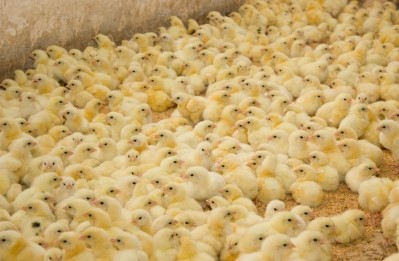special edition: pig & poultry gut health
Enzyme cocktail may boost bird growth, energy use

A Canadian-based research team examined the use of a blend of feed enzymes with a diet that included high levels of rice bran to see if the enzymes could be used to improve the degradation of the fibrous feed ingredient while supporting bird performance and gut health, said Elijah Kiarie, corresponding author and assistant professor in poultry nutrition at the University of Guelph.
“There is a lot of rice bran used in some parts of the world like in Asia and the rice bran is of pretty poor quality there,” he told FeedNavigator. “Some of the problems they see is high fiber and we know the birds cannot digest the fiber – so that’s one of the reasons they’re not able to feed a lot of it.”
“We wanted to see if we could use feed enzymes to help the birds use the rice bran containing feed,” he added.
The research group published its information about its work in the journal, Animal Nutrition.
The researchers found that there was little interaction between the rice bran (RB) and the multi-enzyme supplement (MES) for body weight gain or feed conversion. However, in the later stages of the feeding trial birds receiving the enzyme blend had better weight gain than those on non-supplemented diets.
Birds on high rice bran diets had higher gizzard weight, but lower final body weights, they said. While birds receiving diets supplemented with enzymes had improved growth and energy use.
Using larger amounts of rice bran in poultry feeds would provide a less expensive, alternative feed ingredient for producers, Kiarie said. It also would prevent the ingredient from going unused or being discarded.
“We don’t use a lot of rice bran in broiler feed, most folks put to 5 or 6%, but this data showed you could feed up to 11% with enzymes,” he said. “Which would mean they would be able to use less of the costly feed ingredients like corn or fat or oil – of course, there is always rice bran in the Asian region and it goes to waste most of it. It’s a new way to use more use of that in protein production.”
Why enzymes and rice bran?
The rice bran used in the feeding trial was imported from the Philippines to test the enzyme blend against ingredients like what producers might face in the Asian region, Kiarie said.
Rice is grown around the globe and is the most produced grain following corn and wheat, the researchers said. Rice bran is a co-product of rice processing and about 70m metric tons are generated annually.
Rice bran contains several nutrients needed in feed including amino acids, starch, fat, vitamins and select trace minerals making it a cost-effective feed ingredient for poultry in some parts of the world, they said. However, it also can be prone to rancidity, includes a trypsin inhibitor and is high in both phytate and fiber, which limit its usefulness.
Previous research has generated varied recommendations with some suggesting a 10 to 20% inclusion rate, while other work found that adding 10% reduced feed efficiency, they said.
Feeding trial overview
Prior to the feeding trial, the researchers analyzed the rice bran to find the correct enzymes to use with the ingredient, Kiarie said.
During the two-phase feeding trial, 360 birds received one of four diets, the researchers said. The phases ran from day 0 to day 24 and day 25 through 35.
The diets included a corn-soybean-based control, that diet with the enzyme blend, the diet with rice bran at 5% – in the first phase – and 11% – in the second phase – and the control diet with both rice bran and the enzyme blend added, they said.
The enzyme blend included “xylanase, β-glucanase, invertase, protease, cellulase, α-amylase and mannanase with targeted activity of 2,500, 300, 700, 10,000, 1,200, 24,000, and 20 U/kg of feed, respectively,” the researchers said.
Birds were tracked for body weight and feed intake and excreta samples were collected for analysis during the last three days before the end of each phase, they said. A selection of birds was harvested on days 24 and 35 to measure gut weight and evaluate ceca digesta for organic acid content.
Results and remaining questions
Overall the group found that there was not a strong connection between the enzyme use and the increased amount of rice bran, said Kiarie. However, the result was unexpected.
“We actually expected a much greater response with the enzyme,” he said. “We didn’t have a great connection … the enzyme worked, but it didn’t matter if the diet had rice bran or not.”
There was no interaction between the rice bran or the enzyme blend regarding body weight gain, feed conversion or feed intake, the researchers said.
In the initial phase birds receiving diets with rice bran or the enzyme blend gained more weight – those getting both tended to be the heaviest, they said. In the second phase birds getting the enzyme blend had improved body weight gain but adding the rice bran reduced weight gain compared to birds on diets without the ingredient.
However, the final body weight for birds getting diets with both the enzyme and rice bran tended to be higher than for birds getting neither, they said.
“The rice bran is much cheaper if they’re able to cut the amount of corn and soy they’re using, or corn and fat and use rice bran it would probably save money,” Kiarie said of what the finding could mean for poultry producers. “And, of course, all that rice bran you feed doesn’t go to waste – it would be a new way of using it to create high-value product, animal products and protein.”
Adding rice bran also boosted gizzard weight for birds during both phases of the feeding trial, the researchers said. In the second phase of the trial, there also was an interaction between the enzyme and rice bran use on levels of propionic and iso-butyric acids in the ceca digesta.
The increase in gizzard weight when more of the rice bran was added to the diet likely relates to the additional grinding that the organ has to do, said Kiarie. “The kinds of feed we give chickens now days doesn’t have structure or grit to make sure that the gizzard muscle develops or becomes strong,” he added.
“That’s why you see in phase 1 and phase 2 one of the biggest impacts is increased gizzard weight,” he said. “Because you’re putting fiber in [the diet], the muscle it slows the digestion.”
Bird performance improved in the first phase of the feeding trial because of the added rice bran, which helped develop the gizzard, said Kiarie. However, the reduction in performance came when there was too much fiber added.
“There is an amount of fiber you can’t go beyond – then you need the enzyme when you have more than 5% to make sure you have the effective performance,” he said.
In addition to the performance results the group also tracked the potential influence on gut health stemming from the use of feed enzymes, he said. “We did try to understand the impact of these in fermentation,” he added.
The use of enzymes can alter the nutrients provided to the ceca and make them more useful to the chicken and the beneficial bacteria developing there, he said. Fiber-degrading feed enzymes can generate a prebiotic in the gut, which influences the ceca and alters the fermentation profile.
Given the results from the initial testing, there is some consideration that a different dose of the enzymes blend might have produced clearer results, Kiarie said. “We only had one dose … I think it would have been better if we had different doses of enzymes – we probably would have seen something different,” he added.
In the future there also would be interest in tracking the amount of energy released when the enzyme is used, he added.
Source: Animal Nutrition
Title: Growth performance, gastrointestinal weight, microbial metabolites and apparent retention of components in broiler chickens fed up to 11% rice bran in a corn-soybean meal diet without or with a multi-enzyme supplement
Authors: J. Sanchez, A. Thanabalan, T. Khanal, R. Patterson, B. Slominski, E. Kiarie
DOI: doi.org/10.1016/j.aninu.2018.12.001
















